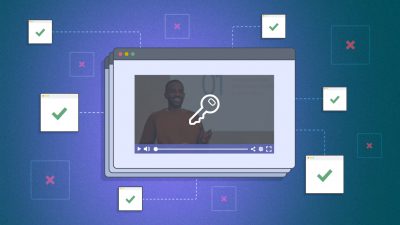In these uncertain times, we’re hearing a lot about prepping for, and coping with, potential disasters. The best way to prevent a calamity of any kind from crippling your business is to be well-prepared ahead of time. A robust business continuity plan is vital to ensuring employees know where to turn and what to do if the unthinkable hits home.
At the core of a durable business continuity plan is an effective communications strategy. Of course, it should include video. In a time of crisis, video provides the ability to communicate fully and with nuance, which is essential when so much is unknown. Here’s how to incorporate video into your continuity plan to prepare your business for anything.
What is a Business Continuity Plan?
A business continuity plan is your company’s roadmap for maintaining productivity in the face of adverse events beyond your control. Usually, you only turn to a continuity plan when a serious disaster of some sort strikes. Think floods, pandemics, earthquakes, or even armed conflict.
It’s easy to assume you’ll figure things out when and if the time comes. However, it’s far more advisable to have a plan ready to go so you aren’t scrambling.
A basic business continuity plan consists of guidelines for adjusting key business processes when everyday resources are not available. For instance, a solid plan should account for losing access to your office space; moving employees to remote work; postponing, rescheduling, or relocating major gatherings; reassigning roles if essential personnel are indisposed; managing supply chain disruptions; as well as many risks related to technology, software, and cyber crimes.
Why You Need Video
Beyond answering the basic question of, “how will work get done?”, your continuity plan should also address your communication strategy for when things are going belly up.
Video is an essential tool for both fronts. For both internal and external purposes, video is the glue that can help hold an organization together and keep things moving forward.
Displaying Leadership
If you’re turning to your business continuity plan, you’re dealing with some sort of crisis. In times like these, strong leadership is essential.
A faceless email can only do so much to reassure anxious coworkers. Seeing a familiar face, with the right tone of voice and nuanced delivery, can really enhance the impact of a message.
Internal Communications
Regular messaging from executives can help align teams and keep employees focused on your company’s mission. Try to set a cadence you can maintain, assuming a busier-than-usual workload.
This is a perfect opportunity to take stock of the situation, offer reassurances, and provide critical updates company-wide.
To ensure your videos remain for employees only, video privacy features like single sign-on, IP address restriction, or requiring viewers to login are easy ways to control access.
Public Relations Messaging
Remember, it’s not just your employees who might look to you for leadership. It’s also your customers, and potentially the general public. By displaying leadership in a crisis, you can help ensure others will think of your brand as reliable.
Customers will want to know whether your company will continue to provide goods and services going forward. If you anticipate disruptions of any kind, it’s best to be transparent since most customers will understand there are mitigating circumstances at play. Further, leaving people to wonder what’s happening when their order doesn’t ship or they can’t reach anyone on the phone will only make things worse.
If your company is taking special steps to help those in need during the crisis, video is the perfect way to explain what you’re doing, and encourage widespread sharing of your message. Video helps make dense information easier to digest, and people are more likely to share information if they have an emotional reaction to it.
To reach customers, embedding a video on your website or blog, or including a video in an email campaign is a great way to get the word out. To reach the general public, sharing your content on social media or in a press release are excellent options.
Reaching Remote Employees
In this day and age, not coming to the office is hardly a reason to stop working. However, there are challenges to remote work that video is uniquely suited to solve.
Video Resources
When you can’t just wander over to someone’s desk for help with a problem, you need somewhere else to turn. Creating video resources for employees to answer quick FAQs about key business processes, especially ones newly enacted to deal with changing circumstances, is essential to helping people adapt to the new reality.
If you are scrambling to put these resources together, our guide to making video with just a laptop might help. We also cover how to make a professional screencast in our How To Video series.
Once you have your content in place, create a video resource center by embedding video in your intranet, or by creating a secure video portal with a third party. For instance, SproutVideo’s websites offer single sign-on, password protection, and more privacy tools to ensure only employees can access this content.
Video Chats and Messages
While Slack, Microsoft Teams, and other professional messaging apps have displaced email significantly, it’s hard to replace face-to-face meetings in lots of circumstances. Video chats are essential when you can’t be in the same place at the same time and need to discuss something important.
The key to ensuring everything moves online smoothly in a crisis is already having a tool in place. Introducing new tools when teams are already dealing with extraordinary circumstances can lead to confusion and lost productivity.
Slack, Zoom, and Whereby are all popular choices for video chats. No matter which tool you use, setting an agenda, avoiding interruptions, and noting key takeaways and action items, are essential to keeping video chats productive.
Sometimes, you can’t even manage to schedule a video chat. However, video can still be used to share important messages with your team. For instance, providing feedback using a screen capture instead of typing it up could be more efficient.
Online Events
In situations where large gatherings are no longer possible, conferences, big meetings, and similar events can be a headache and a half to cancel. Online video offers alternatives that can save the day.
Try to get recorded presentations from the participants to share, or use webinars or livestreams to showcase the presenters instead. You might not be able to get the whole lineup on camera, but hearing from some of the experts will still feel valuable to erstwhile attendees.
Failing that, our tips for leveraging video for public relations above should come in handy if the event needs to be delayed or canceled outright.
Putting it All Together
No matter where you are in your disaster recovery planning process, it’s never too late to make changes for the better. Review (or create) your plans today to identify the points at which video can be leveraged. Then, ensure the teams involved are aware of the communications strategy you’ve put in place, and that they have the resources they’ll need to produce and share video accordingly.
In trying times like these, we are here to help with any of your video questions, large or small. Share them in the comments below!








